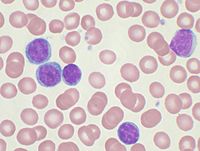
Photo from wikipedia
Objectives Preclinical studies showed that BRAFV600E mutation significantly reduced radioiodine uptake and decreased the sensitivity to radioactive iodine (RAI) therapy. However, clinical data regarding its role in therapeutic decision making… Click to show full abstract
Objectives Preclinical studies showed that BRAFV600E mutation significantly reduced radioiodine uptake and decreased the sensitivity to radioactive iodine (RAI) therapy. However, clinical data regarding its role in therapeutic decision making with respect to RAI therapy are currently insufficient. Thus, this study aimed to evaluate the effect of BRAF mutation on the clinical response to RAI therapy for papillary thyroid microcarcinoma (PTMC) with intermediate-risk to high-risk features. Patients and methods From January 2012 and October 2015, consecutive patients with PTMC with intermediate-risk to high-risk features who underwent RAI therapy were retrospectively included. The data about BRAF mutation status were also obtained. The association between clinicopathological characteristics and mutation was investigated. After a median follow-up of 40 months, the clinical response to RAI therapy was also compared between positive and negative mutation groups. Results A total of 236 patients were included, of whom 147 (62.3%) had positive mutation. The clinicopathological features did not show significant correlation with BRAF mutation status except the sex, extrathytoidal extension and T stage. Patients with PTMC with BRAF mutation showed an increased likelihood of having advanced T stage and extrathyroidal extension. In addition, this mutation did not affect the clinical outcome of RAI therapy. Conclusion The status of BRAFV600E mutation may not affect the clinical response to RAI therapy for patients with PTMC with intermediate-risk to high-risk features. More trials examining the role of BRAF mutation in guiding postoperative RAI therapy are needed.
Journal Title: Nuclear Medicine Communications
Year Published: 2019
Link to full text (if available)
Share on Social Media: Sign Up to like & get
recommendations!